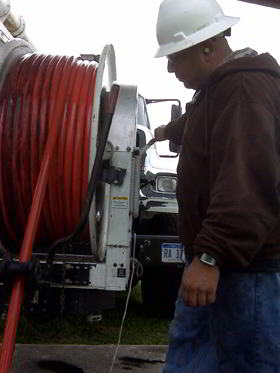
Using powerful Vactor combination units, Hydro Spy Vacuum Excavation Services provides line cleaning for municipal, commercial and industrial entities. If you’ve got a storm drain that has sediment accumulating to the point of blockage, give us a call. We will come out, assess your situation and provide an on-site estimate.
If video inspection is required, we will provide a quote for that as well. For large culverts that have been neglected for years or engulfed with silt or other debris due to weather conditions, such as flooding or hurricanes, let our project managers outline a plan of action to clear the blockage and keep your drainage systems flowing year-round.
Similar to hydro excavation, vacuum excavation line cleaning uses a combination of pressurized water and other manually operated tools to safely unclog grease, sludge and other sediment and debris buildup from the thousands of miles of city sewer lines, culverts and storm drains that run through our communities.
The application is very similar to hydro excavation. Hydro excavation employs a vertical spray technique during the excavation process. Water penetrates the ground, and the vacuum system sucks up the mud.
With line cleaning, pressurized water propels specialized nozzles through sewer lines or large culvert clean-outs. As the nozzle moves through the line, the water jets sand, trash and debris back toward the vacuum hose or tube. Debris is vacuum up instantaneously. The entire process is operated from surface level and is safe, quick and clean.
For extra-large man-entry type culverts or storm drains, on the other hand, the process typically involves confined space entry, which our crews are trained to perform, and the use of water jets, shovels and wheelbarrows in conjunction with a truck-mounted vacuum system to get the job done.
The process begins and ends at street level and can only be performed safely with a minimum of four men: one operator, one qualified confined space attendant and two technicians or laborers. With the vacuum excavation unit staged at the first of a series of manholes, the manhole cover is removed and an air/gas monitor is used to test the space before personnel are allowed to enter.
Once the culvert is deemed safe to enter, no less than two men wearing safety harnesses with lanyards first check in with the confined space attendant then climb down a ladder into the manhole.
Once adequate ventilation and lighting have been established, jetting tools, wheelbarrows and other equipment are staged inside the culvert. The operator then lowers the vacuum tubes into the culvert, and the excavation process begins.








